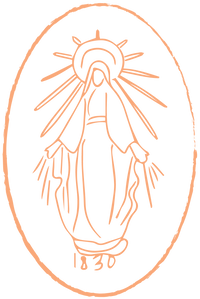What Happened to St. Agnes?

Written by Sarah Feeney, friend of Stella & Tide
St. Agnes might be the best-known of the early virgin martyrs in the history of Christendom. She has long been honored and venerated within the Church and is one of only eight women given the privilege of being named in the Canon of the Mass. The Church Fathers repeatedly extolled her and in the words of St. Jerome, St. Agnes “is praised in the literature and speech of all peoples, especially in the Churches…” Moreover, in the 1,700 years since her death, knowledge of St. Agnes has spread outside the Church. So, who is St. Agnes and what lessons can we glean from her life today?
The Life of Saint Agnes
Tradition tells us that St. Agnes was born into a wealthy, early Christian family in the Roman Empire in A.D. 291, seven years into the Roman Emperor Diocletian’s reign. Diocletian was responsible for the Great Persecution of Christians from A.D. 303 until A.D. 311. During this time, he published a series of edicts that rescinded Christians’ rights, including requiring all copies of Scripture to be burned, ordering churches to be destroyed, and all clergymen to be arrested.
It was during this time of persecution that Agnes grew up, gaining beauty, wisdom, and grace. Her beauty and her family’s wealth made her highly desirable to wed, but she promised God that she would remain a virgin. When men proposed to her, her response was always the same, “Jesus Christ is my only Spouse.” When the governor’s son proposed to her, she is said to have replied, "I am already promised to the Lord of the Universe. He is more splendid than the sun and the stars, and He has said He will never leave me!" The men she turned down were insulted and began to disclose her Christian faith to the authorities.
The Martyrdom of Saint Agnes
There are various accounts of the punishments St. Agnes received after being reported as a Christian; however, it’s unknown which aspects are factual and which may be legendary.
One account says that the governor promised he would give Agnes wonderful gifts if she would deny God. After Agnes refused to do so, the governor chained her up, but Agnes’ face was said to have shone with joy. Another account says that Agnes was condemned to be stripped and dragged through the streets to a brothel; the men who attempted to violate her were immediately struck blind and as Agnes prayed, her hair grew and covered her body. A third account tells that St. Agnes was sentenced to be burned at a stake, but the flames would not touch her body, which led her to be beheaded or stabbed in the throat.
Although there are various accounts of her life and the miracles associated with it, all agree that St. Agnes was martyred on January 21, A.D. 304, at only 12 or 13 years old.
The Example of Saint Agnes
St. Agnes was a child when she was martyred, but her spiritual maturity defied her age and her actions showed that she valued Jesus above all else. As St. Ambrose of Milan poignantly wrote, “there was little or no room in that small body for a wound. Though she could scarcely receive the blow, she could rise superior to it.”
We should all strive to emulate St. Agnes and her spiritual maturity. While we all travel different paths to holiness, a key characteristic of growing in spiritual maturity is adopting the habit of prayer, which can be defined as the “raising of one’s mind and heart to God or the requesting of good things from God” (CCC 2559). Fortunately, the Catholic Church has a rich tradition of prayer, the chief of which is the holy sacrifice of the Mass.
Additionally, Catholics can pray the Rosary or the Chaplet of Divine Mercy, attend Adoration at their local parish, pray a novena to a particular saint, meditate on Scripture, or end the day with an examination of conscience. All forms of prayer can help us grow in spiritual maturity and devote our lives to Jesus just as St. Agnes did—without fear.
In commemoration of her feast day, let’s ask St. Agnes to pray that we can develop a strong prayer life and grow in spiritual maturity so that we may one day join her and all the saints in Heaven.
“Let the little children come to me; do not stop them; for it is to such as these that the Kingdom of God belongs.”
—Jesus Christ (Mark 10:14)
St. Agnes is available as a charm selection for our Custom Saint Necklace, Custom Saint Bracelet, and Floral Cross & Saint Necklace





Thank you for this biography of St. Agnes. So little is known about her but I will,also share this with others. She is the Patron Saint of my mother since she was born on Jan. 21st.
I was surprised that she is the only women’s mentioned in the Canon of the mass, one of 8. It is with joy that I go forward to have a special devotion to her since now, I know details of her very short life and devotion to purity.
———
Stella & Tide replied:
Thank you so much for your comment, Teresa! We’re so happy to hear that this post helped inspire your devotion to St. Agnes. God bless!
Leave a comment